One of the programs of this year's Le Giornate del Cinema Muto in Pordenone is 'Birth of the Western'. As a tribute to the heroes of the early Western, today at EFSP twelve postcards of legendary silent film cowboys.
Image may be NSFW.
Clik here to view.
British or American postcard in the Novelty Series, no. D6-6. Photo: Essanay Films.
The first star of the Western was American actor, writer, film director, and producer Gilbert M. 'Broncho Billy' Anderson (1880-1971). Anderson played three roles in the first Western, The Great Train Robbery (Edwin S. Porter, 1903). He directed and starred in almost 400 Broncho Billy films over a seven year period.
Image may be NSFW.
Clik here to view.
French postcard by Edition Paramount, Paris.
William Surrey Hart (1864–1946) was an American silent film actor, screenwriter, director and producer. He entered films in 1914 where, after playing supporting roles in two short films, he achieved stardom as the lead in The Bargain (Reginald Barker, 1914), his first Western. He became a foremost Western star of the silent era who played characters with honor and integrity. Hart was particularly interested in making realistic Westerns, and his films are noted for their authentic costumes and props. Hart also had an extraordinary acting ability, honed on Shakespearean theatre stages in the United States and England.
Image may be NSFW.
Clik here to view.
French postcard by A.N., Paris, in the series Les Vedettes de Cinéma, no. 77. Photo: Paramount Film.
Europe had its own Western heroes, like Charles de Rochefort (1887-1952),a star of the French silent cinema. He appeared in 34 films between 1911 and 1932, including Westerns like Roi de Camargue/King of Camargue (André Hugon, 1921). In 1923 he went to the US and made several films in Hollywood. After his return to France, he became a film director of sound films.
Image may be NSFW.
Clik here to view.
French postcard by Editions Cinémagazine, no. 118.
Joë Hamman (1883-1974) was another French equivalent of the cowboy. Hamman played in many French Westerns, often filmed in the Camargue in the South of France. In 1907 Hamman started out as both actor and director of Le desperado, followed by performances in some 40 other short westerns until early 1914. These include Un drame mexicain (1909), Un drame au Far West (1909), the tree-part sequel Le vautour de la Sierra (Victorine-Hipolyte Jasset, 1909), Les aventures de Buffalo Bill (1911), and Le railway de la mort (Jean Durand, 1912). He had a long ranging career till 1967, and was also an affluent film director.
Image may be NSFW.
Clik here to view.
German postcard by Photochemie, Berlin, no. K 1439. Photo: Alex Binder, Berlin.
German actor and director Alwin Neuss (1879-1935) also starred in some European Westerns. He started his film career at the pioneering Nordisk studio in Denmark, and was also known for playing Sherlock Holmes in a series of silent films during the 1910s.
Image may be NSFW.
Clik here to view.
German postcard by Ross Verlag, Berlin, no. 3844/1, 1928-1929. Photo: Fox.
American film actor Tom Mix (1880–1940) was the star of many early Westerns between 1909 and 1935. Mix appeared in 291 films, all but nine of which were silent movies. He was Hollywood's first Western megastar and helped to define the genre for all cowboy actors who followed. He developed a comical style, emphasizing fast action thrills to a greater extent than had been common in earlier Westerns, and he did his own stunts. In addition to Mix's riding and shooting skills, the films also showcased the talents of his amazing horse, Tony the Horse.
Image may be NSFW.
Clik here to view.
French postcard by A.N., Paris, in the series Les Vedettes de Cinema, no. 6. Photo: Universal Film / Roman Freulich, no. 203.
One of silent film's earliest superstars was American actor and cowboy Harry Carey (1878-1947). Carey's rugged frame and weather-beaten face were well suited to Westerns. One of his most popular roles was as the good-hearted outlaw Cheyenne Harry. Carey discovered director John Ford and starred in Ford's first feature film, Straight Shooting (John Ford, 1918). He was the father of Harry Carey Jr., who also became a prominent Western actor.
Image may be NSFW.
Clik here to view.
Danish postcard by J. Chr. Olsens Kunstforlag. Eneret, no. 432.
From 1914 to 1925, American actor William Farnum (1876-1953) was one of the biggest sensations in Hollywood, earning $10,000 a week. Farnum's silent pictures include the Westerns The Spoilers (1914) - which culminates in a spectacular saloon fistfight, Drag Harlan (1920) and the drama-adventure If I Were King (1921).
Image may be NSFW.
Clik here to view.![Buck Jones]()
French postcard, no. 5031. Photo: Autrey / Fox.
American film star Buck Jones (1891–1942) starred in many popular B-Westerns of the 1920s, 1930s, and 1940s. Executive William Fox decided to use him as a backup to Tom Mix. This led to his first starring role, The Last Straw (Denison Clift, Charles Swickard, 1920). With his famed horse Silver, Jones would make more than 160 films credits.
Image may be NSFW.
Clik here to view.![Eddie Polo]()
German postcard by Ross Verlag, no. 4469/2, 1929-1930. Photo: Boston Film.
Eddie Polo (1875–1961) was an Austro-American actor of the silent era. He was born Edward W. Wyman or Weimer in Vienna, Austria-Hungary. With his brother Sam he was the trapeze act The Flying Cordovas. He was the first man to parachute off the Eiffel Tower. Beginning in 1913, he appeared in serials and films in the USA and as Cyclone Smith, he became a popular Western hero. During the late 1920s, he was an action star in the German silent cinema. After his acting career ended in the mid-1940s he worked as a makeup artist.
Image may be NSFW.
Clik here to view.![Ken Maynard]()
German postcard by Ross Verlag, no. 4561/1, 1929-1930. Photo: Defina / First National Pictures.
Ken Maynard (1895–1973) was one the superstars among the film cowboys. Reportedly, he began his career as a trick rider with the Buffalo Bill Wild West Show and later with Ringling Brothers (some sources deny this). From 1924 on, he worked in Hollywood and made some 20 silent westerns. He was famous for the stunts he could enact with his horse Tarzan. Maynard was the first singing cowboy in the movies.
Image may be NSFW.
Clik here to view.![Tim McCoy]()
British postcard by Rotogravure. Photo: Columbia Pictures.
Light-haired and blue-eyed American actor Tim McCoy (1891–1978) was one of the great stars of the early Western. He was also a decorated military officer and expert on American Indian life and customs. As a cowboy star, he was so popular with kids that he appeared on the cover of Wheaties cereal boxes.
That's all, folks! Happy trails!
Sources: Wikipedia and IMDb.
Image may be NSFW.
Clik here to view.

British or American postcard in the Novelty Series, no. D6-6. Photo: Essanay Films.
The first star of the Western was American actor, writer, film director, and producer Gilbert M. 'Broncho Billy' Anderson (1880-1971). Anderson played three roles in the first Western, The Great Train Robbery (Edwin S. Porter, 1903). He directed and starred in almost 400 Broncho Billy films over a seven year period.
Image may be NSFW.
Clik here to view.

French postcard by Edition Paramount, Paris.
William Surrey Hart (1864–1946) was an American silent film actor, screenwriter, director and producer. He entered films in 1914 where, after playing supporting roles in two short films, he achieved stardom as the lead in The Bargain (Reginald Barker, 1914), his first Western. He became a foremost Western star of the silent era who played characters with honor and integrity. Hart was particularly interested in making realistic Westerns, and his films are noted for their authentic costumes and props. Hart also had an extraordinary acting ability, honed on Shakespearean theatre stages in the United States and England.
Image may be NSFW.
Clik here to view.

French postcard by A.N., Paris, in the series Les Vedettes de Cinéma, no. 77. Photo: Paramount Film.
Europe had its own Western heroes, like Charles de Rochefort (1887-1952),a star of the French silent cinema. He appeared in 34 films between 1911 and 1932, including Westerns like Roi de Camargue/King of Camargue (André Hugon, 1921). In 1923 he went to the US and made several films in Hollywood. After his return to France, he became a film director of sound films.
Image may be NSFW.
Clik here to view.
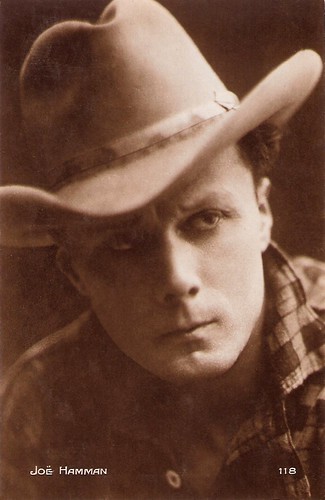
French postcard by Editions Cinémagazine, no. 118.
Joë Hamman (1883-1974) was another French equivalent of the cowboy. Hamman played in many French Westerns, often filmed in the Camargue in the South of France. In 1907 Hamman started out as both actor and director of Le desperado, followed by performances in some 40 other short westerns until early 1914. These include Un drame mexicain (1909), Un drame au Far West (1909), the tree-part sequel Le vautour de la Sierra (Victorine-Hipolyte Jasset, 1909), Les aventures de Buffalo Bill (1911), and Le railway de la mort (Jean Durand, 1912). He had a long ranging career till 1967, and was also an affluent film director.
Image may be NSFW.
Clik here to view.
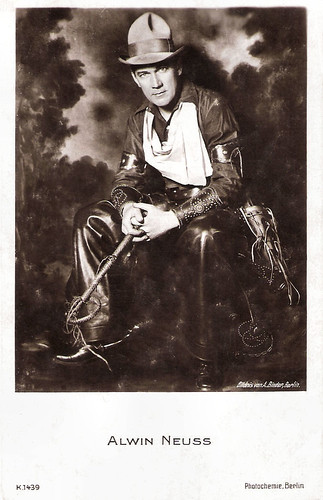
German postcard by Photochemie, Berlin, no. K 1439. Photo: Alex Binder, Berlin.
German actor and director Alwin Neuss (1879-1935) also starred in some European Westerns. He started his film career at the pioneering Nordisk studio in Denmark, and was also known for playing Sherlock Holmes in a series of silent films during the 1910s.
Image may be NSFW.
Clik here to view.
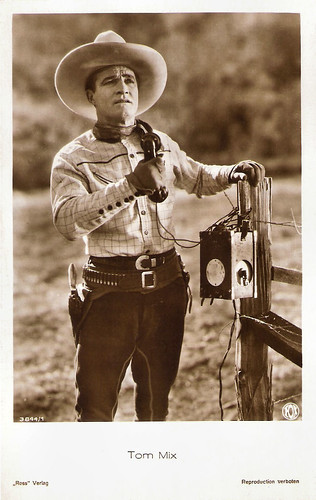
German postcard by Ross Verlag, Berlin, no. 3844/1, 1928-1929. Photo: Fox.
American film actor Tom Mix (1880–1940) was the star of many early Westerns between 1909 and 1935. Mix appeared in 291 films, all but nine of which were silent movies. He was Hollywood's first Western megastar and helped to define the genre for all cowboy actors who followed. He developed a comical style, emphasizing fast action thrills to a greater extent than had been common in earlier Westerns, and he did his own stunts. In addition to Mix's riding and shooting skills, the films also showcased the talents of his amazing horse, Tony the Horse.
Image may be NSFW.
Clik here to view.
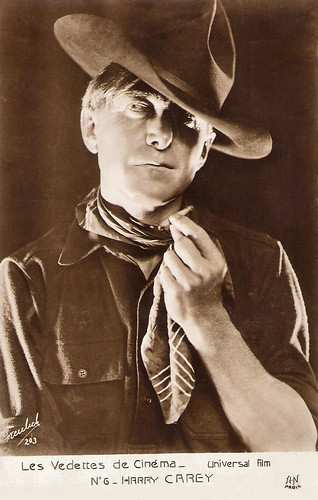
French postcard by A.N., Paris, in the series Les Vedettes de Cinema, no. 6. Photo: Universal Film / Roman Freulich, no. 203.
One of silent film's earliest superstars was American actor and cowboy Harry Carey (1878-1947). Carey's rugged frame and weather-beaten face were well suited to Westerns. One of his most popular roles was as the good-hearted outlaw Cheyenne Harry. Carey discovered director John Ford and starred in Ford's first feature film, Straight Shooting (John Ford, 1918). He was the father of Harry Carey Jr., who also became a prominent Western actor.
Image may be NSFW.
Clik here to view.
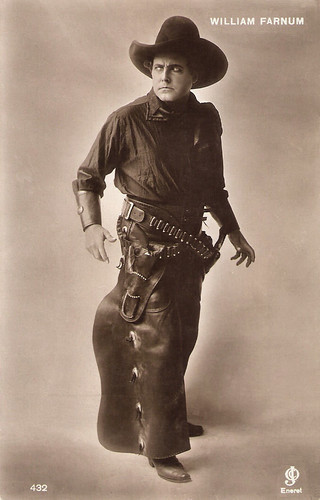
Danish postcard by J. Chr. Olsens Kunstforlag. Eneret, no. 432.
From 1914 to 1925, American actor William Farnum (1876-1953) was one of the biggest sensations in Hollywood, earning $10,000 a week. Farnum's silent pictures include the Westerns The Spoilers (1914) - which culminates in a spectacular saloon fistfight, Drag Harlan (1920) and the drama-adventure If I Were King (1921).
Image may be NSFW.
Clik here to view.

French postcard, no. 5031. Photo: Autrey / Fox.
American film star Buck Jones (1891–1942) starred in many popular B-Westerns of the 1920s, 1930s, and 1940s. Executive William Fox decided to use him as a backup to Tom Mix. This led to his first starring role, The Last Straw (Denison Clift, Charles Swickard, 1920). With his famed horse Silver, Jones would make more than 160 films credits.
Image may be NSFW.
Clik here to view.

German postcard by Ross Verlag, no. 4469/2, 1929-1930. Photo: Boston Film.
Eddie Polo (1875–1961) was an Austro-American actor of the silent era. He was born Edward W. Wyman or Weimer in Vienna, Austria-Hungary. With his brother Sam he was the trapeze act The Flying Cordovas. He was the first man to parachute off the Eiffel Tower. Beginning in 1913, he appeared in serials and films in the USA and as Cyclone Smith, he became a popular Western hero. During the late 1920s, he was an action star in the German silent cinema. After his acting career ended in the mid-1940s he worked as a makeup artist.
Image may be NSFW.
Clik here to view.
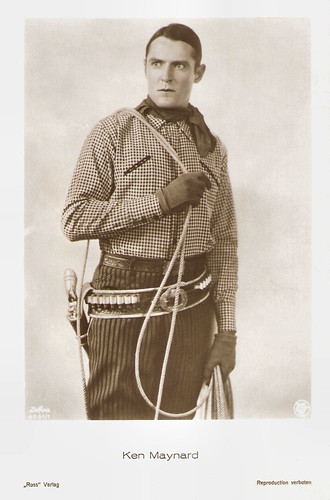
German postcard by Ross Verlag, no. 4561/1, 1929-1930. Photo: Defina / First National Pictures.
Ken Maynard (1895–1973) was one the superstars among the film cowboys. Reportedly, he began his career as a trick rider with the Buffalo Bill Wild West Show and later with Ringling Brothers (some sources deny this). From 1924 on, he worked in Hollywood and made some 20 silent westerns. He was famous for the stunts he could enact with his horse Tarzan. Maynard was the first singing cowboy in the movies.
Image may be NSFW.
Clik here to view.

British postcard by Rotogravure. Photo: Columbia Pictures.
Light-haired and blue-eyed American actor Tim McCoy (1891–1978) was one of the great stars of the early Western. He was also a decorated military officer and expert on American Indian life and customs. As a cowboy star, he was so popular with kids that he appeared on the cover of Wheaties cereal boxes.
That's all, folks! Happy trails!
Sources: Wikipedia and IMDb.